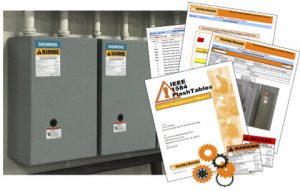FlashTables™ based on IEEE 1584
FlashTables™ based on IEEE 1584: Based on IEEE 1584 incident energy equations, labels can be applied and documented in a fraction of the time needed for a full-blown Incident Energy Analysis, Arc Flash Analysis, or Arc Flash Study.
 FlashTables™ based on IEEE 1584, is an Intellectual Licensed Product that can be installed by Facility Results for about 1/3 of the cost of other methods. FlashTables™ is ideal for facilities that are dynamically changing, and the intent is to label all electrical panels on the plant floor. The average manufacturing facility requires 500 labels and that arc flash analysis can be OSHA compliant in one week or less.
FlashTables™ based on IEEE 1584, is an Intellectual Licensed Product that can be installed by Facility Results for about 1/3 of the cost of other methods. FlashTables™ is ideal for facilities that are dynamically changing, and the intent is to label all electrical panels on the plant floor. The average manufacturing facility requires 500 labels and that arc flash analysis can be OSHA compliant in one week or less.
FlashTables™ based on IEEE 1584 (Arc Flash Study or Arc Flash Analysis)
FlashTables™ has been implemented by some of the largest manufacturing companies in the world. The IEEE 1584 Standard for arc flash calculations is the foremost incident energy analysis identification authority. FlashTables™ has captured the incident energy outcomes in a table format and can be implemented and have your facility OSHA compliant in one week or less in most cases.
FlashTables™ allows you to install labels in the entire facility on a budget over time. You can order as few as 100 labels installed on your timeline. Change management could not be simpler. Once the initial installation is complete, provide us with the basic nameplate information, and we can ship you the appropriate labels to be installed by your team in real time.
FlashTables Unlimited is a reverse-engineered method based on IEEE 1584 analysis and calculations or arc flash analysis (for incident energies required on arc flash hazard labels). With the NEC style tables, engineering is done up-front and accurately so incident energy can be determined for the label on the spot and a 70% cost savings. Instead of data collection, you have data verification which is the information you need to find the appropriate look-up table. FlashTables is a booklet of incident energy tables so you can look up your incident energy requirements for PPE to be put on the label and apply a pre-printed label for all of the electrical equipment in a plant (based on specific company-PPE level requirements).
What this arc flash study method has:
– IEEE 1584 accuracy for determining incident energy. Validated.
– Ability to do complex industrial plants with switchgear, MCC, bus plugs, relays, looped systems, adjustable trip breakers
– Ability to provide IEEE 1584-based labels down to the lowest point 208V and up to 15kV
– No wait time
– 70% less cost, including labels on equipment
– Report available for audits of every applied label
– Tested/validated on over 200,000 label points in industrial and commercial applications each year
What this arc flash analysis method doesn’t have (but SKM, ETAP, and EasyPower Do)
– Report generated one-line
– Coordination / Mitigation study
– Short circuit study
Other Related Services:
 Onsite Arc Flash Training
Onsite Arc Flash Training
 Hazard/Risk Category (HRC) Assessment
Hazard/Risk Category (HRC) Assessment
 Engineer-Assisted Incident Energy Analysis
Engineer-Assisted Incident Energy Analysis
 Turnkey Incident Energy Analysis
Turnkey Incident Energy Analysis
